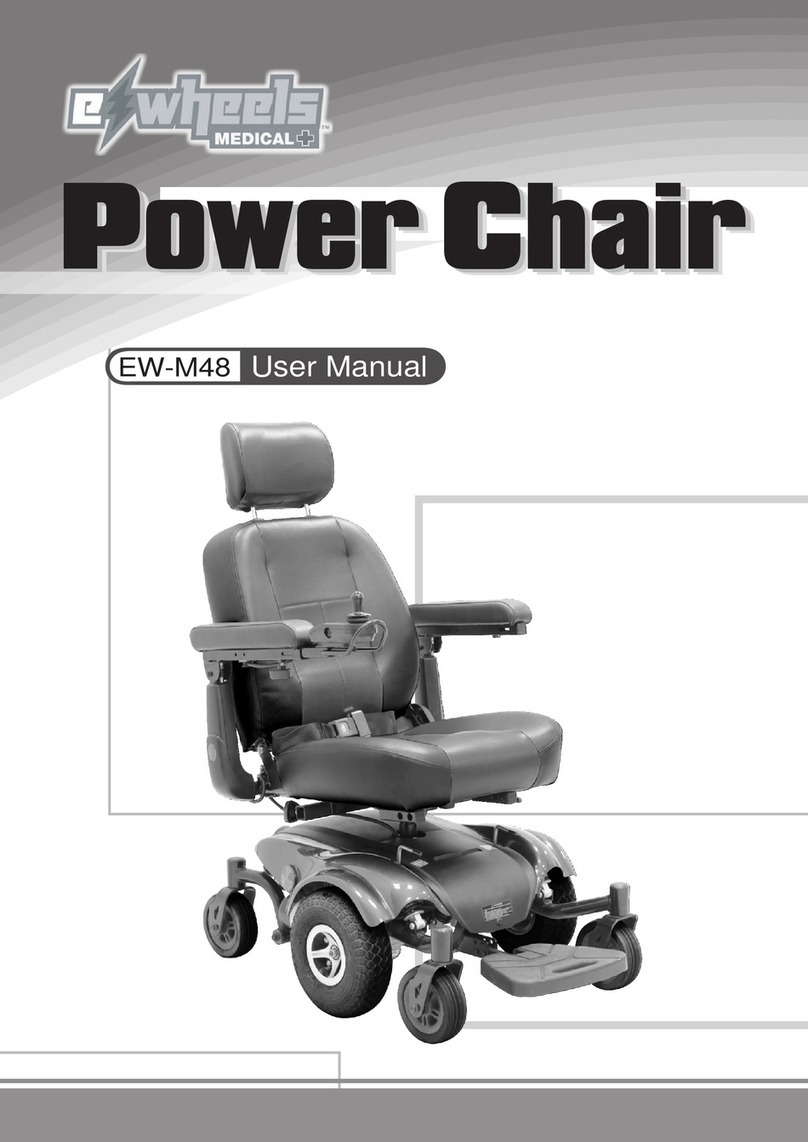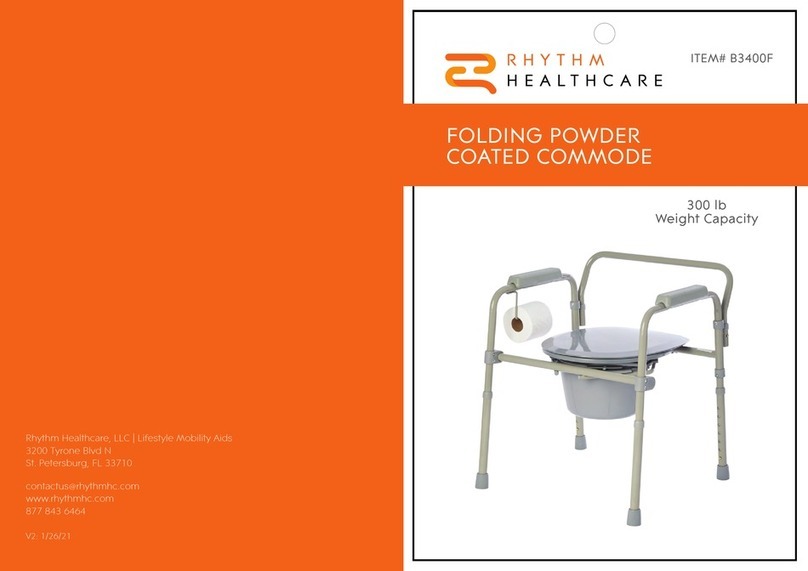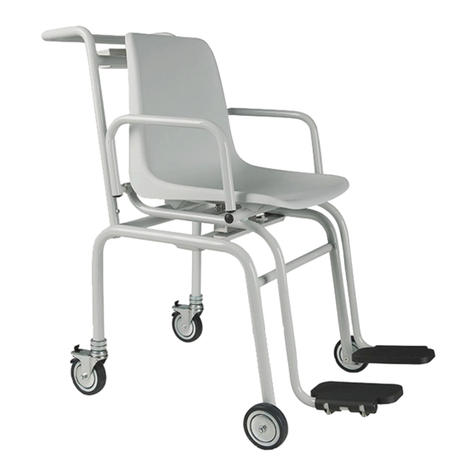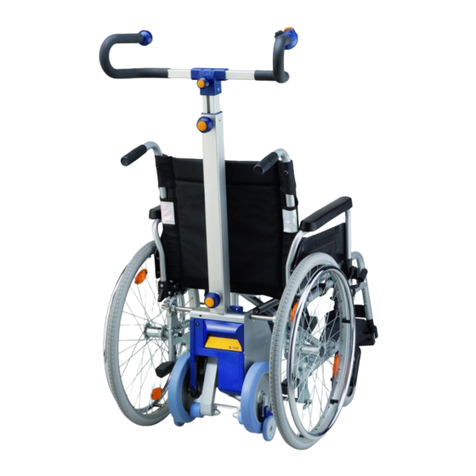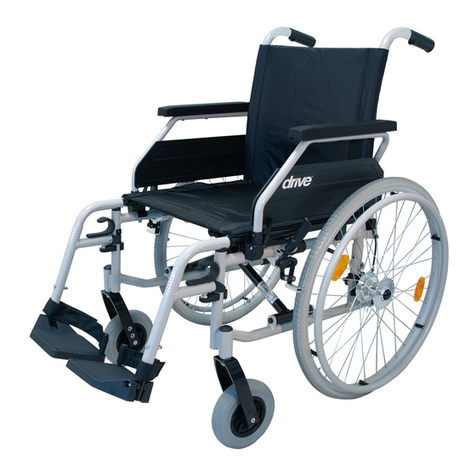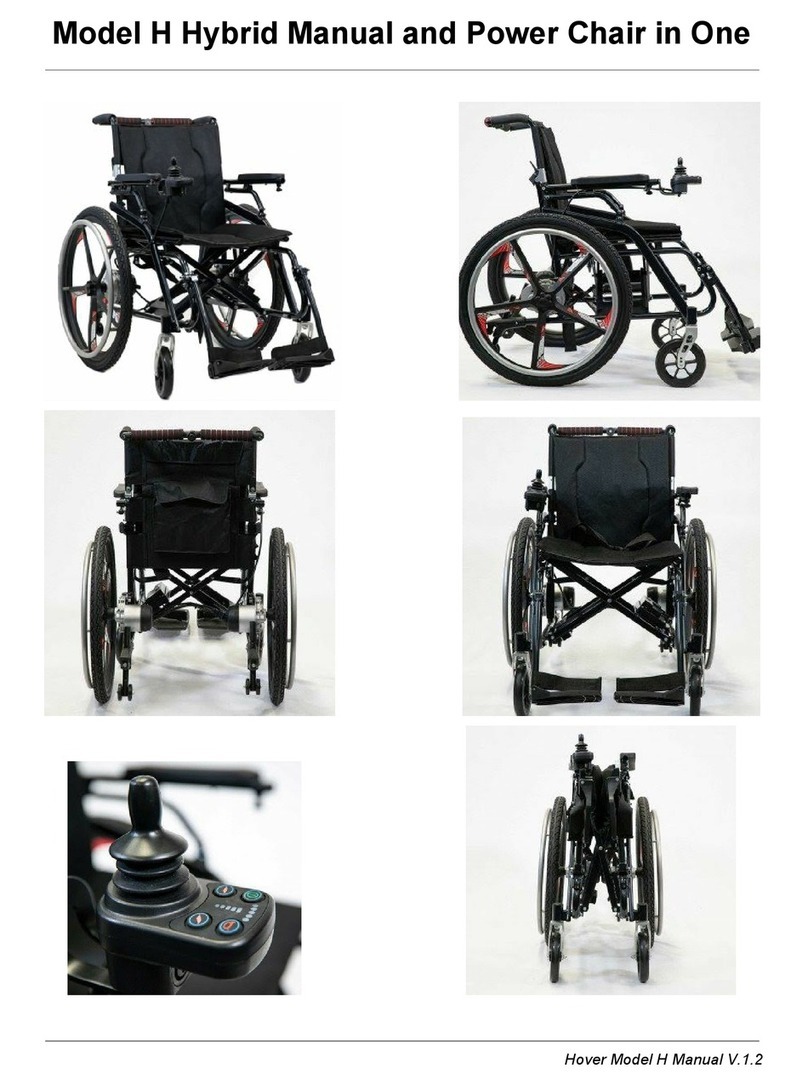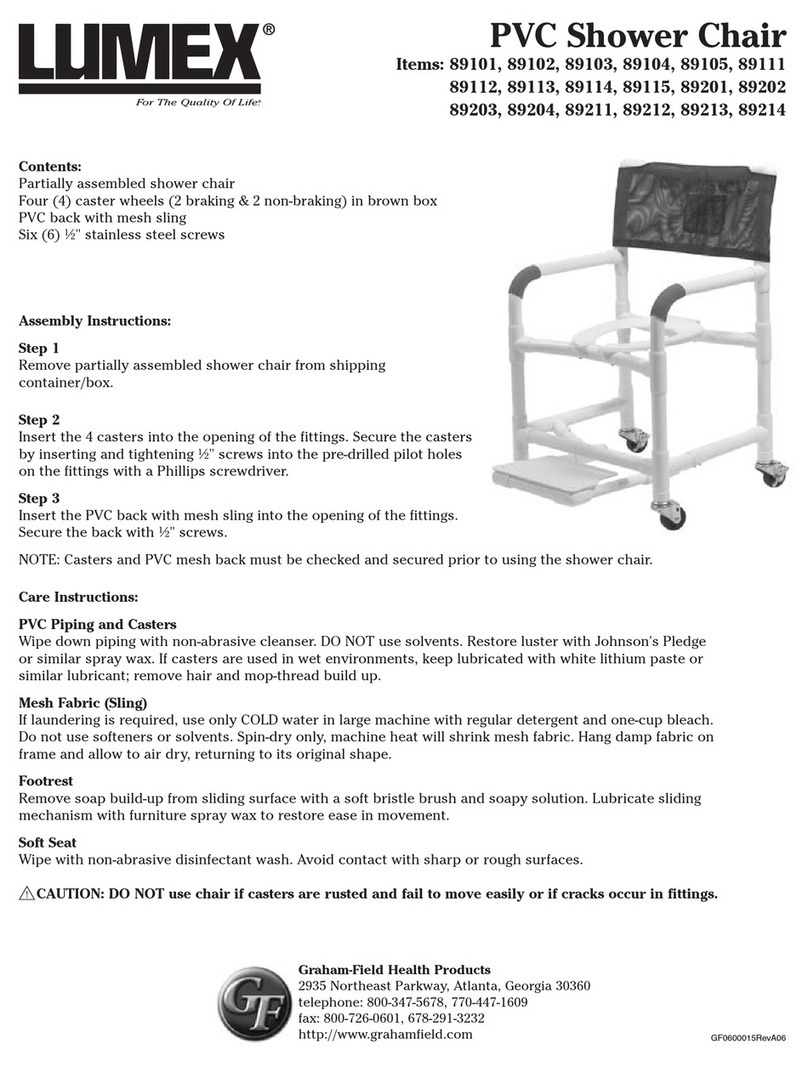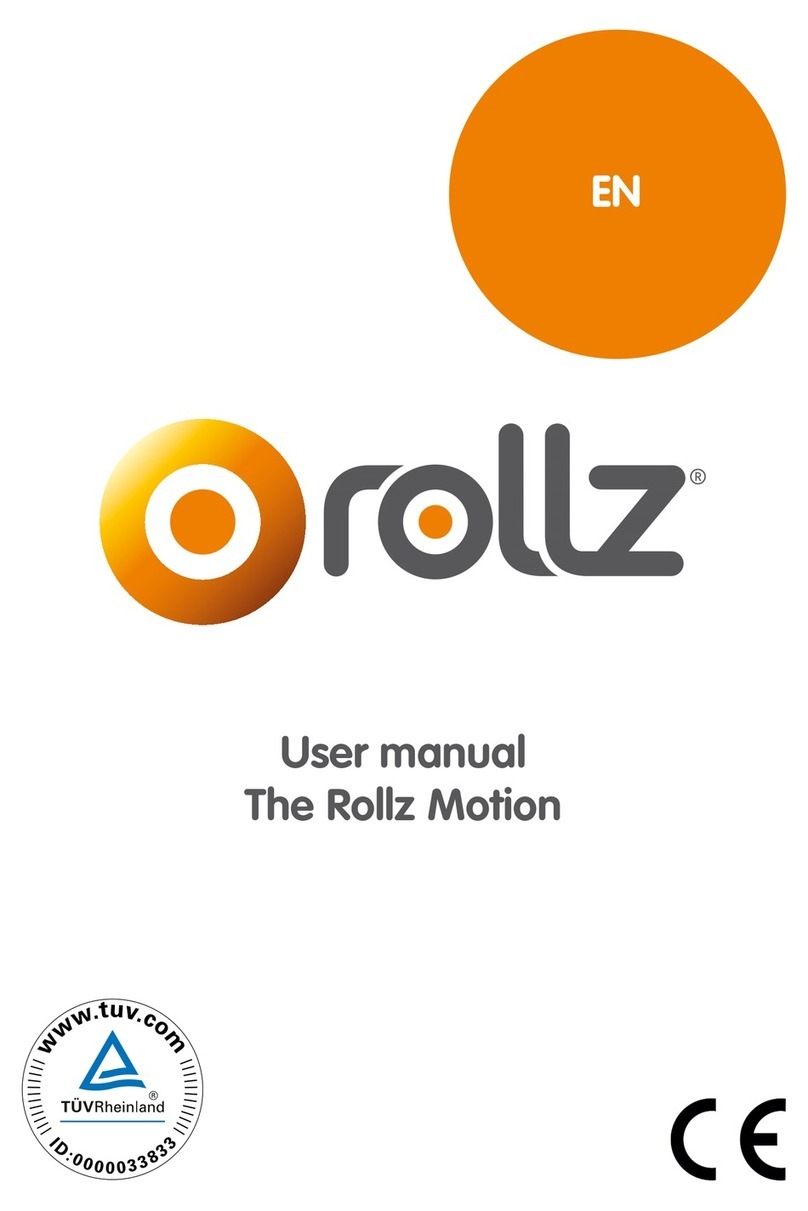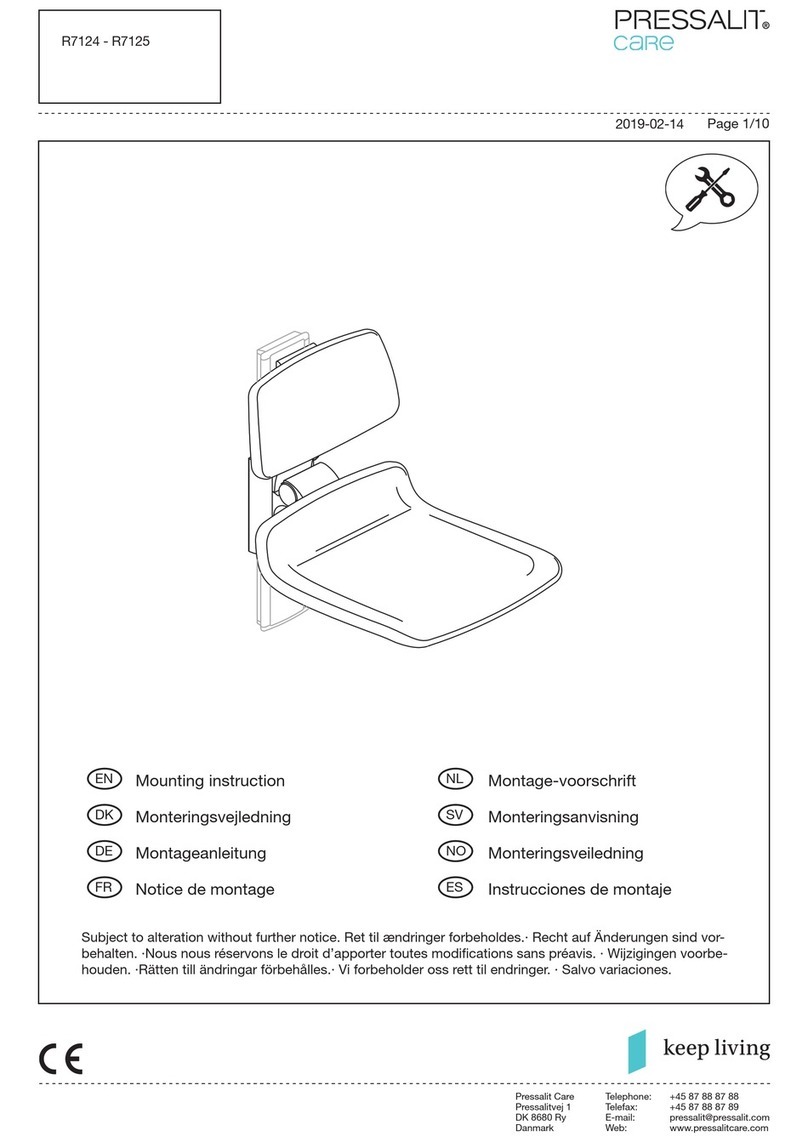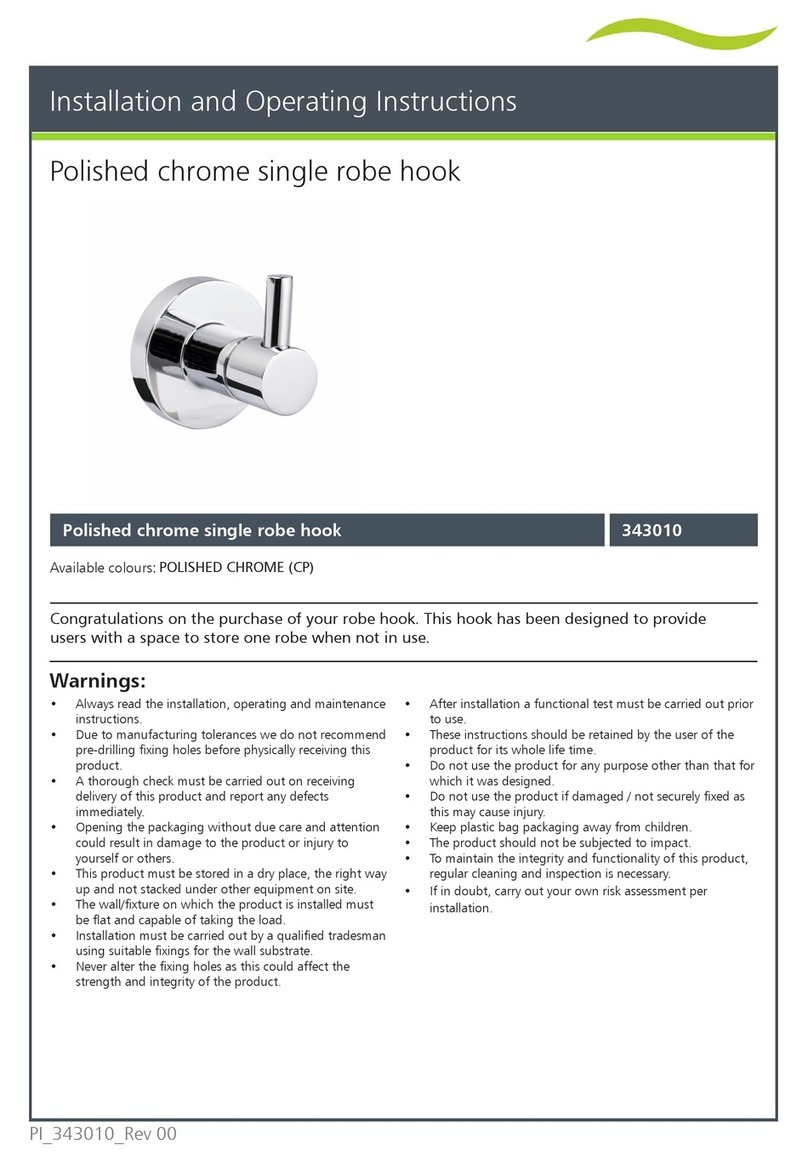ewheels EW-43 User manual

1.INTRODUCTION..................................................................................................... 1
2.SAFETY USE......................................................................................................1-3
3.STRUCTURE AND PERFORMANCE................................................................ 4-5
4.SPECIFICATION....................................................................................................6
5.INSTALLATION, FOLDING AND DEBUGGING................................................. 7-8
6.USEING AND OPERATION .............................................................................9-13
7.FAULT DIAGNOSIS AND TROUBLESHOOTING................................................13
8.SAFETY DEVICES ANDACCIDENT TREATMENT............................................14
9.MAINTENENCE AND REPAIR...............................................................................14-16
10. TRANSPORTATION AND STORAGE..............................................................17
11.OPENING AND CHECKING...............................................................................17
12.QUALITY ASSUARANCE............................................................................17-19
FIGURES.....................................................................................................20

1
2
Read and follow all instructions, warnings, and notes in this manual before attempt-
ing to operate your power wheelchair for the first time. If there is any information in
this manual which you do not understand, or if you require additional assistance for
assembly or operation, please contact with your authorized local provider.
These symbols below in this manual are used to identify warnings and important
information. All of them are very important to your safety. It is stronglyrecommended
that you should read and understand them completely.
1. INTRODUCTION
1.1 This product integrates advanced technology with modern style. Especially, its
structure for quick dis-assembly and assembly are very convenient for you to store
or place at the trunk of your vehicle while traveling. We are certain that the design
features, excellent performance and trouble -free operation of this product will
ensure your daily life more convenient.
1.2 This product is suitable for all the disabled persons, the elderly and the infirm
who have difficulty in walking. The maximum user weight is300LBS.
1.3 This product is of an outdoor type. It is of Model EW-43.
1.4 This product is suitable for an outdoor use and the flat streets near buildings for a
middle distance, but not for the grass, gravel, or slope of more than 10 degrees and
motorized roads, rainy or snowy days,either.
2.SAFETY USE
2.1 This power wheelchair is energy, non-asepsis, reusable product without chemical
substances.
The safe and period of validity for wheelchair on the clinical use not only depends
on its structural strength, but also on the user usage and use of the product environ-
ment, user habits, whether in accordance with the periodic maintenance, mainte-
nance and other factors .
Our products are valid from the date of production for 7 years.
2.2 Instructions before use
2.2.1 If not completely read and understand the user manual, please do notdrive.
2.2.2 The maximum loading capacity is 300LBS,(fig.A)please do not overload
driving. And it is single use, please do not carry passengers.
2.2.3 Please do not drive after drunk or too tired.(fig.A)
2.2.4 Do not drive at night or in the case of a unclear line of sight.
2.2.5 Please self-test before driving and refer to the manual section 5.3 "Commis-
sioning" and 6.2.2"Practice before operation " if driving for the firsttime.
2.2.6 This wheelchair is not waterproof, do not expose in rain and snow as well as
drive in rain or snow.(Fig.B)
2.3 Attention during using
2.3.1 This power wheelchair can drive on a good flat surface, do not drive on muddy,
rugged, soft, narrow, icy road, bad roads without guardrails or waterway. (Fig.C)
2.3.2 This power wheelchair has the certain ability of groove obstacle , at this time
you should reduce the speed and travel slowly.
2.3.3 This power wheelchair has the certain climbing ability, the climbing angle is ≥
6°, but within 10°.(Fig.D)
2.3.4 Please avoid driving in the crowds, traffic and other places with heavytraffic.
2.3.5 Please ensure that the controller system fix well, joystick is straight and correct.
Sit well and promptly fasten protective tape, keep your head as backward as possi-
ble and lean against the backrest in case of bumps on the road, which may lose
control.
2.3.6 Press the on/off button, firstly check if the current fastest speed setting is
appropriate for yourself operating proficiency, or it should be adjusted for safety; We
recommend drive slowly at the beginning for every use, and gradually accelerate as
well.
2.4(EMI)Electromagnetic Interference
Your wheelchair may be traveling in the areas affected by electromagnetic interfer-
ence from some radio transmitters such as radio, wireless intercom, mobile phones
and radars etc. In these cases, your wheelchair’ s driving may be affected by them.
Electromagnetic interference may affect the control system of the electric wheel-
chair. Some disturbances may cause brake failure, automatic start or runaway, and
may cause permanent damage to the control system.
2.4.1 Electromagnetic Interference Classification
▪Short-band radio transceiver. These radios have antennas, such as radio waves in
the urban bands, walkie-talkies, cell phone network systems and signal transmission
devices.

3
4
▪Medium-band mobile radio transceiver. These are usually installed in the building or
outside the vehicle antenna. For example: police, fire, tax, medical ambulance and
other radio transceivers.
▪Large band radio transceiver. These are usually installed on the tower in the anten-
na, such as: commercial radio TV transmission system.
3.STRUCTURE AND PERFORMANCE
3.1 This power wheelchair consists of the main parts including the front wheel, drive
wheel, frame, joystick, motor with mechanism, armrest, push handle, backrest, seat
base, footrest, battery case, and charger,the structure is shown as below.
Push handle
Joystick
Backrest Armrest
Seat base
2.4.2 Prevention of Electromagnetic Interference
●Do not use hand-held radio transceivers when the wheelchair power is turned on,
such as mobile phones, radios, etc;
●Avoid close to the radio transmission system, such as radio stations, television sta-
tions;
●If the electric wheelchair can not control or brake failure, please contact our com-
pany or dealer.
Drive wheel
Battery case
Footrest
Motor with mechanism
Front wheel Charger

5
6
3.2 Product Characteristics of the Power Wheelchair
●Classification by anti-shock type: wheelchair is internal power supply;
●Classification according to the degree of anti-shock: wheelchair belongs to the
B-type application part;
●Classification according to the degree of protection of the feed: IPXO;
●Safety degree when used in flammable anesthesia mixed with air or flammable
narcotic with oxygen or oxidized nitrogen Category: Non-AP or APG equipment;
●By operating mode: continuous operation;
●Rated voltage and frequency of wheelchair: DC 24V;
●Input power of wheelchair: internal power supply equipment;
●Whether the wheelchair has a protective effect on defibrillation effect: No;
●Whether the wheelchair has a signal output and input part: No;
●Permanent installation of equipment or non-permanent installation of equipment:
mobile devices.
3.3 ELECTRICAL DIAGRAM OF POWER WHEELCHAIR
4.SPECIFICATION. Sheet 1
RIGHT MOTOR
CONNECTORS FOR RIGHT MOTOR
GUIDE RAIL TYPE 24V LITHIUM BATTERY
CONNECTORS FOR LEFT MOTOR
3.4Product Software REV.
Controller version of Power wheelchair EW-43 is
V1.6.
LEFT MOTOR
Note:
①The weight capacity is tested with a dummy or personnel of same weight.
②Theoretical Travel Ranging is tested on flat road with average speed. It will vary due todrive surface, operation
habit,etc.
LEFT BRAKE
RIGHT BRAKE
Weight Capacity
300 lbs
Distance Per Charge
9.7 miles
Maximum Speed
3.7 mph
Turn Radius
24.5"
Unfolded Dimensions (LxWxH)
42" x 24.5" x 38.5"
Folded Dimension (LxWxH)
15.5" x 23.5" x 31"
Weight With Battery
60 lbs
Weight Without Battery
56 lbs
Battery Weight
4 lbs
Incline Ability
6 degrees
Front Wheels
8"
Rear Wheels
12"
Seatback Height
21.5"
Seat Width
17.25"
Seat Depth
17.5"
Seat Type
Flat free tires
Seat Height at Front
19"
Footrest To Seat Distance
15.75"
Joystick
Left or right optional
Armrest Height
8"
Armrest Type
Folding armrests
Backrest Angle
10 degrees
Ground Clearance
1.5"
Braking Distance (Flat Surface)
59"
Static Stability
9 degrees
Dynamic Stability
>6 degrees
Slope Performance
>9 degrees
Motor Type
x2 200 watt hub motors
Battery Type
24V, 10AH lithium battery
Charger Type
Offboard 2A charger
Frame Type
Aluminum
Drive Type
Rear wheel drive
Seatbelt
Yes, included
Storage
Removable bag under seat, back seat pocket
Suspension
Front shock absorbers

7
8
5.INSTALLATION, FOLDING AND DEBUGGING
5.1Installation
5.1.1 Take out the wheelchair from packing box to the ground, flip up the footrest,
then connect the battery by inserting it to the end.(fig.1) Pull it out froward and back-
ward with one hand on the backrest and another on the bottompole.(fig.2)
5.1.2 Install the joystick on the armrest(fig.3); Tight the knob on the sleeve(fig.4) to
fix the joystick.
5.1.3 Press the stop pin of anti-tipper fixture(fig.5), which is at the inside of rear
wheel, under the motor. Stretch out the anti-tipper to the limit slot and automatically
clip into the third position.
5.1.4 Put the brake lever to electric mode(fig.7) instead of manual mode(fig.8)
5.1.5 Complete the installation by buckling the locker down(fig.9) and then the
wheelchair is ready for operation.
5.1.6 The method for taking-out battery(fig.10): Press switch ① by hand, and then
pull out the battery easily.
5.2Folding
The wheelchair can be folded to reduce the volume for transportation and storage.
①Power off the wheelchair.
②Adjust the brake lever to electric mode, making sure it is not at the manual mode.
(fig.8)
③Press down the backrest,pull up the locker(fig.11); fold the wheelchair with one
hand pushing the backrest and another hand on the seat tube.(fig.2)
④Flip up the footrest.(fig.12)
1r
st
the wheelchair, in case the wheelchair turns over, causing
ATTENTION personal injury.
2. To avoid the wheelchair falling down, the anti-tippers
must be stretched out and located at the second or third
position when fold the wheelchair.

9
10
6.USEING AND OPERATION
6.1Using
6.1.1 Controller: an absolutely necessary electrical device. All electronic components
to operate the wheelchair are integrated to the device.Usually, the controller is
installed on an armrest, connected together with the motors and batteries to the
power box.
●Switch button: Switch button supplies the
●Charger Socket:It is only used to this wheel-
chair. Do not use the socket to supply power to
any other electrical equipment. Otherwise, it may
damage the wheelchair’ s control system or its
E.M.C performance (Electromagnetic tolerance).
power for control system for electronic equip-
ment, then equipment supplies the power for
motor of wheelchair. Do not use the switch
Battery indicator
Charger socket on the base
Power switch
button to stop the wheelchair unless an emer-
gency situation. Otherwise it may shorten the life
of the wheelchair drive components.
●Joystick: The joystick is mainly used to control
the wheelchair’ s movement including its speed
and direction(forward, backward and left or right
etc). The further you push the joystick from its
central position, the faster the wheelchair
moves. Whenever you release the joystick, it will
automatically go back to the center and the
brake will be automatically operative to stop the
wheelchair.
●Horn button: The horn will sound if you press
this button.
●Speed Up/Down Buttons and Speedometer:
After turning on the power, the speedometer
shows the current maximum speed setting. This
maximum speed setting can be adjusted through
the speed up button or speed down button by
user.
Horn button
Speed indicating light
Speed down button
Speed up button
Joystick
6.1.2 Batteries and Its Usage
Fully charge your new battery prior to its initial use. This brings the battery up to
about 90% of its peak performance level; Give the battery another full charge of 5-8
hours and operate your wheelchair again, the batteries will now perform at over 90%
of their potential; After four or five charging cycles, the batteries will top off at 100%
charge and last for an extended period. Please replace a new battery when the bat-
tery failure, and the used battery must be returned to supplier because of environ-
mental pollution.
Battery specification
Type
Lithium battery
Dimension
12.6’’*3.15’’*2.56’’
Voltage
24V
Amperehour
10AH
6.1.3 Charger Usage
The battery charger is an important part of the wheelchair. The off-board charger
attached to this product can charge its batteries quickly and easily to make your
wheelchair the best.
0 ~3.4MPH
0 ~3.1MPH
0 ~ 2.8MPH
0 ~2.5MPH
automatically.(fig.E)
the control system, then the warranty is invalid.

11
12
Please note below tips when charging:
●Be certain the controller is powered off and the wheelchair is in the electric mode,
instead of the manual mode.
●Connect the 3-pin output plug of the charger to the controller. (Fig.14)
●Connect the power plug of the charger to the standard wall outlet.
●The red LED on the charger lights indicating that charging is in progress. The
green LED on the charger lights when the batteries are fully charged.
●We recommend you to charge the battery for 5-8 hours.
●Remove the charger and power plug when fully charged, and put them into the bag
behind the seat rest.
6.1.4 Safety Belt
For your safety, the safety belt must be fastened before you operate the wheelchair.
(fig.13)
6.2 Operation
6.2.1 Preparation before operation
●Do not turn on the power switch when sit on the power wheelchair, and do turn off
the power switch when get off from the wheelchair.
●Please fold the pedal first then hold the armrest to sit on the wheelchair; Do not get
off the wheelchair by stepping on the pedal. Otherwise the wheelchair maybe turned
over, which is dangerous.
6.2.2 Practice before operation
●Find a spacious place like square and have an assistant to help you practice until
you have enough confidence to operate it.
●Be certain to shut down the power when up and down the wheelchair, and set a
speed you need through speed adjustment button.
●We recommend you set the lowest speed until you can operate the electric wheel-
chair skillfully. (fig.a)
●To practice the stop operation, forward and backward. Push the handle, the wheel-
chair move to anywhere you want.(fig.b)
●Firstly, ensure that it is the lowest speed when practice forward operation. After
Skilled, you can practice “S” shaped turn. After you are familiar with "S" shaped turn,
to practice backward operation, and pay attention to the speed control setting. And
the backward speed should lower than forward speed.(fig.c)
6.1.5 Overload and Undervoltage Protector
The overload and undervoltage protector is set for the wheelchair’ s safety, and
implement the protection function through the on-off of the protective board installed
inside the lithium battery. Once motors overload or undervoltage, it will trip to cut off
the power to prevent the motors and electric components from damage. The protec-
tor function could be recovered by charging the wheelchair or reconnect the batter-
ies.(fig.14)
Forward
Left Right
Backward
fig.a
Start at
the lowest
speed
fig.b fig.c

13
14
6.2.3 Operation
Please do it according to precautions operation.
7.FAULT DIAGNOSIS AND TROUBLESHOOTING
For your convenience of operation, this product has an automatic fault warning func-
tion. Once the wheelchair system malfunctions, the LEDs on the controller will flash
with alarm sounded by the horn. You can find where a fault is according to informa-
tion in Table 8.
If the fault still exists after checking based on table 8, Please consult your service
agent immediately. Table 8
8.SAFETY DEVICES AND ACCIDENT TREATMENT
8.1 Safety belt: Refer to instruction manual 6.1.4
8.2 Overload Protector: Refer to instruction manual 6.1.5
8.3 Please release the joystick whenever there is a wheelchair fault , the wheelchair
will be stopped.
9.MAINTENENCE AND REPAIR
9.1 Maintenance
Like other motorized vehicle, your power wheelchair also requires routine mainte-
nance. Some checks can be performed by yourself, others you can ask for assis-
tance from your service agent. Preventive maintenance is very important. If you
follow the maintenance and checks in this section, your wheelchair will give you
years of trouble-free operation. If you have any doubt about your wheelchair’ s care
or operation, please contact your service agent or our after-sale service dept.
9.1.1 Humidity
Your wheelchair, like most electrical and mechanical equipment, is susceptible to
external conditions. In any case, the wheelchair should be avoided damp environ-
ment. Direct or prolonged exposure to water or dampness could cause the wheel-
chair to malfunction electronically and mechanically. Water can cause electrical
components and the wheelchair’s frame to corrode.
9.1.2 Temperature
●Some parts of your wheelchair are susceptible to temperature.
●In extremely cold temperature, the battery may be frozen. Special temperatures
may cause a lot of factors to freeze, like charger type, usage, battery components
(such as sealed lead-acid batteries or gel batteries);
●Temperature above 55°may cause your wheelchair decelerate.
9.1.3 General Guidelines
●Avoid beating the controller, especially the joystick.
●Avoid prolonged exposure of your wheelchair to extreme conditions, such as hot,
cold or moisture environment.
●Keep the controller clean.
●Check all electric connections, including the cable and connectors of the charger,
and ensure that they are all tight and secure.
●If only red LEDs on the Battery Gauge lights, the batteries are nearly running out of
charge. You should recharge the batteries as soon as possible. We recommend
charging the battery for 5-8 hours.
nel. Please do not set your wheelchair to manual
mode when it is at slope. Ohterwise the wheelchair
will glide without control, resulting in personal injury.
injury maybe caused.
LED display
Fault Diagnosis
Troubleshooting
Remark
1 LED lamp flashes
Low voltage,
undervoltage
Charging
2 LED lamp flashes
The left motor
failure
Check the motor and wiring harness
3 LED lamp flashes
The left motor
failure
Check if the brake lever at the correction
position, if the brake is damaged
4 LED lamp flashes
The right motor
failure
Check if the brake lever at the correction
position, if the brake is damaged
5 LED lamp flashes
The right motor
failure
Check if the brake lever at the correction
position, if the brake is damaged
6 LED lamp flashes
Overcurrent of
controller
Check if the brake is disengaged,if the
wheel is locked-rotor
7 LED lamp flashes
Failure of the
joystick
Check if the joystick is in the center
8 LED lamp flashes
Failure of the
controller itself
Controller fault

15
16
●The frame surface has been sprayed with a clear sealant coating. You can apply a
light coat of car wax to make the surface keep a high gloss.
●Check all cable connections. Make ensure they are fastened and are not corroded.
The battery must be placed in the battery area, flat, the battery plug inward, relative
display, refer to the correct connection on the main frame label;
●All wheel bearings are lubricated and sealed. Do not need to lubricate them.
●Check if there is loose phenomenon for wheel hub, drive device, and chair itself, if
loose, please screw tightly in time.
9.1.4 Maintenance after use
●Turn off the power(please disconnect all the connectors if not use for long time.)
●Inhibit children or unconscious person to use the wheelchair.
●Store the wheelchair in normal temperature to prevent reformation so that it keeps
its performances for long period.
●Clean the wheelchair with a clear and soft cloth and dry it. Never use any chemi-
cals to clean it.(to prevent deformation and discoloration).
●Remove the cloth cover of the seat rest to be washed if it is dirty, and then dry it for
use.
9.1.5 Daily Checks
In order to keep the wheelchair in good condition, you should check before each
use. And to maintain the weekly, monthly, semi-annual investigation.Refer to table 9
for the inspection item. Table 9
9.1.6 Cleaning
Way of cleaning as below.
Clean the wheelchair with dry cloth.
●Never wash your wheelchair with water or expose directly to water.
●Surface of wheelchair frame is coated with a protective coating. Therefore, it is
very easy to wipe it clean with a damp cloth. Never use any chemicals to clean the
vinylon seat and armrest, as they may cause the latter slip or chapped. You can use
a damp cloth and neutral soapy water to clean them, and then dry thoroughly.
9.2 Repairment
9.2.1 Users could repair or replace some spare parts like armrest, push handle
cover which could be self-maintained or replaced by users under the instructions of
after-sales service staff of our corporation or the dealers’.
9.2.2 Within the warranty, our corporation or the dealers will maintain or replace the
faulted spare parts, like motor, battery, charger, controller, bearing, shaft sleeve,
etc., due to material or manufacturing defects free of charge.
9.2.3 The spare parts like motor, controller, etc. which are confirmed by the
after-sale staff of our corporation or our dealers’ to be dissembled could be sent to
our corporation or the dealers for maintenance.
9.2.4 Please contact your distributor or the after-sale service dept. of our corporation
for any questions regarding the mantainence of power wheelchairs. Please refer to
12.1 Product Warranty.
In order to guarantee the quality of power wheelchair,
Please contact us or our dealers to replace the spare parts
with same models and specifications if the consumable
ATTENTION parts like batteries, tyres, controller, motors and charger,
etc. need to be replaced. The maintenance should be pro-
ceeded at our corporation or the dealers’ maintenance
dept.
damage to the battery.
Inspection Items
At any time
Weekly
Monthly
Six monthly
Wheel hubs, Driving mechanism and fasteners
Joystick function
Brake System
Connection
Battery Condition
Tire Condition
Inflation condition of rear wheels
Frame Condition
Motor and actuator condition
Front Wheel Condition
Pureness

17
18
10. TRANSPORTATION AND STORAGE
10.1 Transportation
You can load and transport according to the shipping marks and graphics. For
details, see the attachment.
10.2 Storage
Your wheelchair should be stored in a clean indoor environment with ambient tem-
perature of 0℃-50℃,relative humidity ≤80% , good ventilation and free from corro-
sive gas. Remove the batteries from the wheelchair prior to storage. Otherwise, the
frame may rust and the electronics may be damaged.
11.OPENING AND CHECKING
Please check if any parts missed or damaged.
NO.
Name
Quantity
Remarks
1
Power wheelchair
1
Model:EW-43
2
Charger
1
Model: HP0060W(L2)-M
3
Manual
1
4
Pedal
1
5
controller
1
12.QUALITY ASSUARANCE
12.1 Warranty
12.1.1 5-year warranty for wheelchair fraem
12.1.2 Within 1 year from the purchase date, for the following parts, we will supply
free maintenance and/or replace service for original customer after the dealer check
there are materials and production defects.
●Electrical control or joystick system
●Motor/Drive System
●Bearing and shaft sleeve
12.2Warranty- Medical Scooters
Models Included
EW-M33, EW-M34, EW-M35, EW-M39, EW-M40, EW-M41, EW-M43, EW-M45, EW-
M47, EW-M49, EW-M50, EW-M81, EW-M82, EW-M83, EW-M91, EW-M92, EW-M93.
Three Year Limited Warranty
Three (3) years from the date of purchase on all structural frame components, seat
post and frame.
One Year Limited Warranty
One (1) Year from the date of purchase, if any part or electronic component of the
scooter is found upon examination to be defective in material and/or workmanship, it
will be replaced at Ewheels discretion.
Six Month Warranty
Six (6) Months from the date of purchase on the batteries and charger. Batteries are
subject to a stringent wear and tear clause. Any battery faults due to a manufacturing
defect will become obvious within the first two months of use. Any gradual deterioration
in performance after this period is normal and associated with fair wear and tear,
misuse or accidental damage and as such is not covered by the manufacturer’s
warranty.
WARRANTY EXCEPTIONS AND EXCLUSIONS
Service and Labor Costs
Unless previously authorized, service calls and labor costs are NOT included or
covered under any warranty. The purchaser is responsible for the delivery to the
authorized repair facility. Satisfactory proof of purchase is always required for warranty
service. Please contact Ewheels directly for any assistance in locating a service
provider or to make a warranty claim.
Consumable Items
Consumable items which may need replacing due to normal wear and tear like tires,
tubes, lights, chains, upholstery and seating, brakes and brake pads, cables, fuses,
buttons, shrouds and covers.
Damage, Accidental Damage and Misuse
Damaged caused by: battery fluid spillage or leakage, abuse, misuse, accident,
negligence, improper operation, excessive loading, maintenance, storage, acts of God,
commercial use, or use other than normal, extreme riding, modifications and
alterations.
Second Hand Owners and Reselling
No warranty will be offered or honored for second hand owners. The warranty is

17
18
exclusively offered to the original purchaser.
HOW TO MAKE A WARRANTY CLAIM
Initiating A Warranty Claim
To initiate a warranty claim, please contact Ewheels service department by calling
warranty claims will be fulfilled, satisfactory proof of purchase will be required, and a
photo or video of the damaged part must be sent and reviewed by Ewheels.
Returning Faulty Parts
Do not return faulty parts to Ewheels without prior consent. A request for a return
authorization is required prior to returning items. All transportation costs and shipping
damage incurred while submitting units and/or parts for repair or replacement are the
responsibility of the original purchaser.
SHIPPING DAMAGE AND SHIPPING POLICIES
Shipping Damage
In the event shipping damage occurs, it must be reported and addressed in a timely
manner. Shipping damage claims are time sensitive and cannot be delayed. In the
event the packaging is extremely damaged and the bike is beyond repair, please
refuse the shipment, and contact Ewheels for further steps.
Shipping –Domestic
When applicable, part costs will be covered under warranty, and all warranty items will
be shipped via FedEx Ground. Shipping fees will be at the expense of the purchaser.
Shipping –International
When applicable, parts will be provided under warranty at no charge, but shipping to
any offshore and/or international location will be the responsibility of the original
purchaser. International and offshore end-users must contact Ewheels directly to
initiate the warranty process.
*Implied warranties, including those of merchantability and fitness for a
particular purpose, are limited to one (1) year from the date of the
original purchase and to the extent permitted by law. Any and all
implied warranties are excluded. This is the exclusive remedy.
Liabilities for consequential damages under any and all warranties are
excluded*

19
20
The name and symbols of the signs
No.
Sign
Meaning
1
Fragile objects inside the packaging,please handle with care.
2
Keep the packaging up during transportation.
3
Keep the packaging avoid from rain
4
The max. layers of stacking same packaging is 2.
5
Hand hook are forbidden when carry on transport
the packagings
6
Application type B.
7
Plummeted Droplets(condensed water for example do not
damage the electrical appliance)
8
Warning、Attentions、Caution.
fig.A
fig.B
10°
fig.C
fig.D
fig.F
fig.E
Table of contents
Other ewheels Wheelchair manuals
